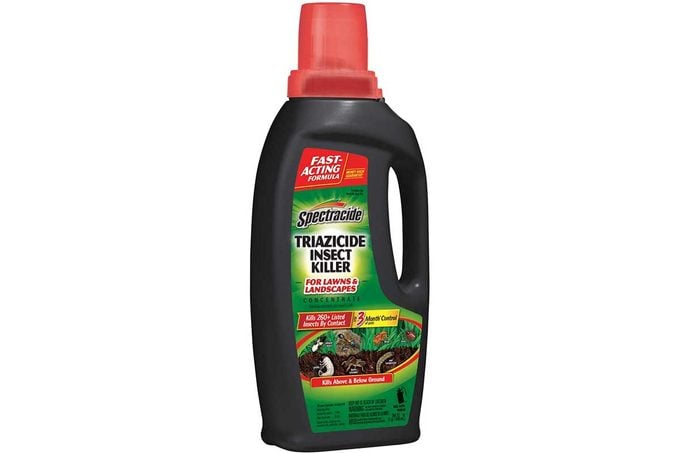Do you know what’s impressive about leaf beetles? Their staggering numbers and variety.
There are at least 35,000 species of leaf beetles, 2,000 of which are found in North America. They come in a range of colors, from shimmering green and gold to red striped or yellow striped. They vary from a familiar plump, rounded form to bizarre, alien-like structures that are as fascinating as they are strange. And left unchecked, leaf beetles can do a lot of damage to your ornamental and vegetable gardens.
Here’s what you need to know about leaf beetles and how to get rid of them.
What Are Leaf Beetles?
Leaf beetles are in the Chrysomelidae family of beetle species. They’re one of the most widely dispersed of all beetles — and that’s saying a lot because beetles are the largest animal group on earth!
As their name suggests, leaf beetles feed on the leaves, stems, roots, flowers and fruit of plants and food crops. They range in size from less than 1/16-inch up to about 3/4-inch. All species of leaf beetles can fly, which makes it easy for them to disperse across a wide habitat. They can live in a range of climates, although a hard or sustained winter freeze can kill off populations.
Types of Leaf Beetles
Some leaf beetles target only one type of food crop, like soybeans or potatoes, while others are less discriminating. Here are some of the leaf beetles you’re most likely to see in your home garden:
- Bean leaf beetle (Cerotoma trifurcata). Ranging from yellow to red with distinctive black markings, these pests prefer soybeans but will also chomp on green beans, clover, pumpkins and cucumbers.
- Cereal leaf beetle (Oulema melanopus). Typically red with dark blue wings, these crop pests prefer cereal grains but will also go after ornamental grasses.
- Colorado potato beetle (Leptinotarsa decemlineata). This destructive yellow-and-black-striped beetle likes potatoes and most nightshades, including eggplant, pepper and tomatoes.
- Cucumber beetles include several species of leaf beetles. Both the bugs and the larvae feed on vegetable plants.
- Mexican bean beetle (Epilachna varivestis). As cute as ladybugs but way more destructive, these spotted, orangish beetles can do a number on your legumes.
- Scarlet lily leaf beetle (Lilioceris lilii). This small, bright-red beetle wreaks havoc on lillies, hollyhock and hostas.
- Tuber flea beetle (Epitrix tuberis Gentner). This small black beetle feeds on potatoes and root vegetables.
- Viburnum leaf beetles (Pyrrhalta viburni). These invasive brown beetles can decimate pretty viburnum shrubs.
How Leaf Beetles Impact the Garden
“Leaf beetles will feed on plant tissue and can cause significant injury and death to plants and trees,” says Josh Matta, senior biologist for Spectrum Brands, which produces a range of household products, including insecticides. Leaf beetles can also spread diseases through contact and weaken plants to the point that they are susceptible to other diseases and pests.
While most leaf beetle damage to fruits and vegetables is cosmetic, they can weaken young plants and reduce crop yields.
Signs of Leaf Beetles
Most signs of leaf beetles are visible directly on the plant leaves. According to Matta, some common signs include:
- Small holes in leaves;
- Leaves are discolored or covered in dark droppings;
- Yellow and brown leaves, which eventually fall to the ground;
- Leaves are partially or completely “skeletonized” where the beetles have chewed most of the leaf tissue, causing significant damage;
- In fruits and vegetables, small round holes, sometimes with a larger brown area around them.
How to Get Rid of Leaf Beetles

You can eradicate leaf beetles in your garden through chemical or natural methods. Matta recommends a Spectrum Brands product, Spectracide Ready-to-Spray Triazicide Insect Killer for Lawns & Landscapes.
“To protect your lawn and gardens, mornings are the best times to spray, when insects are sluggish,” he says. “Be sure to read and follow the instructions on the label.”
If you prefer a more natural method, fill a spray bottle with water and about four tablespoons of dish soap. Spray beetles where you see them on your plants, making sure to check the undersides of leaves. You can also hold leaves over a wide jar or bucket filled with soapy water. Tap the leaves so that the beetles fall into the water — they won’t last long in the soapy solution.
How to Prevent Leaf Beetles From Coming Back
Because leaf beetles are most active in the spring and summer, Matta says planting later in the spring could help you avoid many of the adults that have been overwintering.
“It’s also important to care for and maintain your garden regularly,” he says. “Make sure to remove leaf litter and dead branches, and control weeds. Inspect your plants for damage regularly and treat them as soon as you notice damage.”
Some other ideas for leaf beetle prevention include:
- Planting aromatic herbs, such as garlic, mint or rosemary near plants that are vulnerable to leaf beetles — the smell helps keep the pests away.
- Encourage birds and bats in your yard by installing birdbaths and feeders, and bird and bat houses.
- Consider releasing ladybugs (not lady beetles!), which are natural predators of many leaf beetles and their eggs and larvae.
Article source here: How to Get Rid of Leaf Beetles in Your Garden


No comments:
Post a Comment